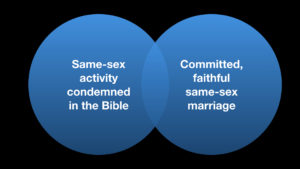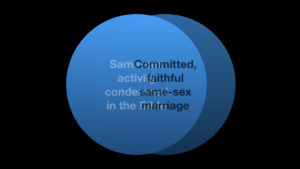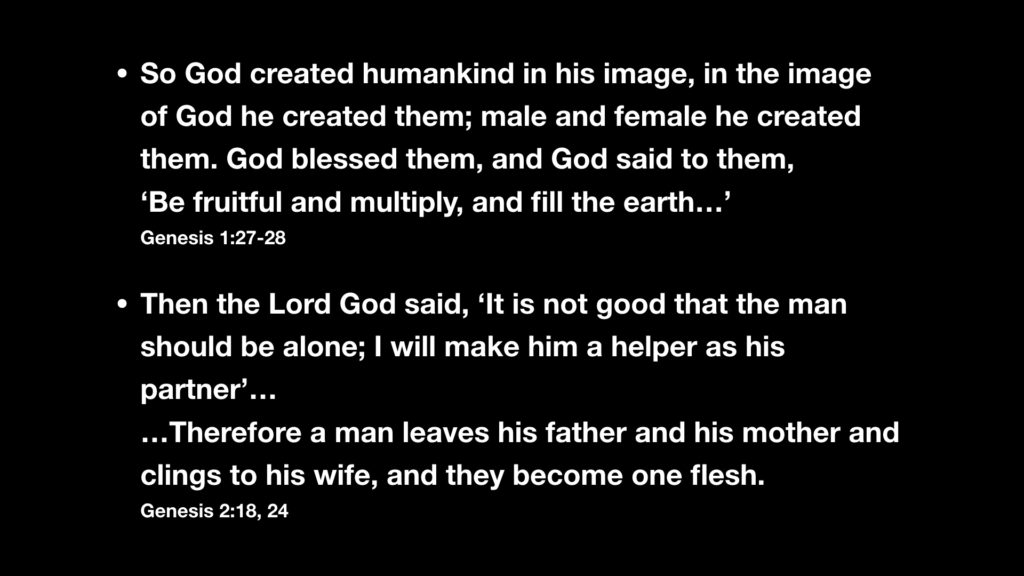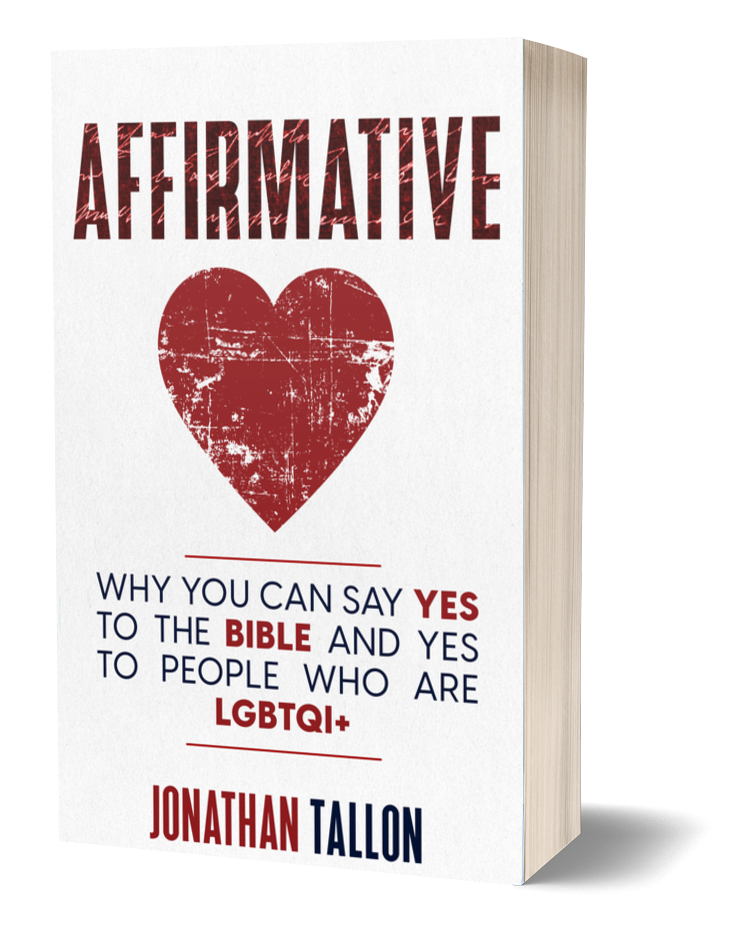This video explains why Christians should not consider homosexuality an abomination because of Leviticus. The video first explains the context in which Leviticus 18:22 and 20:13 were written: male temple prostitutes for pagan goddesses and pederasty. It then goes on to how Christians use Leviticus generally. It is not a rule book to be followed, because the Law’s time has come to an end, fulfilled in the single command to love. It makes no more sense to condemn Christians who are gay as practising abomination than it does Christians who sport tattoos, wear mixed fibres, or eat ham and cheese sandwiches.
Transcript
The book of Leviticus in the Bible says that homosexuality is an abomination, and so it can’t possibly be right for Christians.
You’ve heard this? Keep watching to find out why I disagree.
There are two verses from Leviticus that figure in the debates over the Bible and homosexuality. First of all Leviticus 18:22, which says:
You shall not lie with a male as with a woman; it is an abomination.
And the second one is similar. It comes from Leviticus 20:13:
If a man lies with a male as with a woman, both of them have committed an abomination; they shall be put to death; their blood is upon them.
To understand these verses, we need to know a little bit about the background to them. First of all though, some general points about this section of Leviticus.
The holiness code
Because this section, between chapters 17 and 26, is often called the holiness code because of the emphasis throughout it on holiness, on being holy, on being pure. And so what you eat, what you do, what you are, all these things can affect how holy you are, how pure you are.
 And so eating the wrong food makes you less holy [Lev. 20:25]. Having a tattoo makes you less holy [Lev. 19:28]. Wearing clothes from different fibres – like wool and linen together – makes you less holy [Lev. 19:19]. Even having a physical disability makes you less holy [Lev. 21:16-23].
And so eating the wrong food makes you less holy [Lev. 20:25]. Having a tattoo makes you less holy [Lev. 19:28]. Wearing clothes from different fibres – like wool and linen together – makes you less holy [Lev. 19:19]. Even having a physical disability makes you less holy [Lev. 21:16-23].
What’s going on here? In part, the holiness code is encouraging the Israelite people to be pure, to be separate from, to be different from their pagan worshipping neighbours. And everyday life becomes a symbol of that purity, that holiness – the Israelite people are not to assimilate to surrounding cultures, just as different types of fibres shouldn’t be in the same cloth.
Background to the verses
So what’s going on in the two verses that we’re looking at? First of all, these verses are addressed only to males – there is no mention here of two women. Secondly, how are the Israelite people going to be distinct from, different from their neighbours by putting these into practice?
Well, in the surrounding cultures, the major socially acceptable form of same-sex activity was with male shrine prostitutes as part of temple worship to pagan gods and goddesses. And there is repeated rhetoric against these shrine prostitutes at different parts of the Hebrew Bible [see Deut. 23:17; 1 Kings 14:24 (linked with abomination), 15:12, 22:46, 23:7].
Looking wider afield, there were cultures like Ancient Greece, where the dominant form of male-male intercourse was (usually married) men with boys – pederasty. And did you notice that the verses said a man lying with a male, not a man lying with a man?
Now, occasionally I’ve seen some commentators claim that this is trying to link it back to Genesis (male and female he created them), but if so it is rather strange that ‘female isn’t used’; it’s ‘as with a woman’ and not ‘female’.
I think it more likely that ‘male’ is used here precisely because it can include lying with boys as well as men.
So two main contexts for the Israelite people to be different from – male-male intercourse linked with pagan temple goddess worship, and pederasty.
Note how different these are from what we are looking at today; with faithful, loving, committed relationships.

So if we take these two verses seriously as a guide for Christian life, we have to understand the context in which they would have been heard.
How should we apply these verses (and others from Leviticus)
But there’s actually a much bigger issue here. If you’re a Christian rather than orthodox Jewish, why are you assuming that you have to obey these verses anyway?
Because if you are going to obey these verses strictly – then why not the whole verse? Leviticus 20:13 says – ‘they shall be put to death’. Do you want the death penalty for homosexuality? If you don’t, you’re ignoring part of the verse. If you do – are you consistent? Do you want also want the death penalty for adulterers (that’s from just three verses before)?
 And what about tattoos? Should everyone with a tattoo be cut off from the community? Or what about clothes with mixed fibres – I hope you don’t have any cotton-polyester blends in your wardrobe. And don’t even get me started on ham and cheese sandwiches.
And what about tattoos? Should everyone with a tattoo be cut off from the community? Or what about clothes with mixed fibres – I hope you don’t have any cotton-polyester blends in your wardrobe. And don’t even get me started on ham and cheese sandwiches.
The first church argument was about whether non-Jewish Christians had to keep the law, the Torah, of which Leviticus is a part. It forms the backdrop to some of Paul’s letters, and the Acts of the Apostles. And the outcome?
Christians don’t have to keep the Law.
Why not? Because, with the arrival of the Messiah, Jesus, the time of the Law has come to an end. [Romans 10:4; Galatians 3:24-26].
We have been given a new law – the law of love. Love God, and love your neighbour [Galatians 5:14]. So it doesn’t matter whether you get a tattoo, or wear a cotton-polyester blend, or work on a Saturday (which is the Sabbath).
The only thing that matters is whether what you are doing is loving.
I sometimes get people asking, but the part these verses are in deal with sexual morality, and surely that doesn’t change, that’s constant.
Well, just three verses away it says: You shall not approach a woman to uncover her nakedness while she is in her menstrual uncleanness. [Leviticus 18:19]. Or, to be more direct, no intercourse during her period.
For Leviticus, this is sexual immorality; it is just as bad, just as abominable, as a man lying with a male.
Yet I’ve never heard any warnings about not having intercourse during a period in any sermon, haven’t come across it in any Christian book or Christian marriage preparation course.
Why not? Because we don’t think it applies, because the time of the Law has come to an end. The only law is the law of love.
Conclusion
To recap – the context for the verses is intercourse with male shrine prostitutes at temples to pagan goddesses, or intercourse between married men and boys. But in any case, it doesn’t matter – Christians don’t look to Leviticus for particular rules for life. Christ has given us the only rule we need – love one another.
So, if I’m honest, I don’t really understand the appeal to Leviticus as meaning that homosexuality is condemned by God. Why pluck these two particular verses out of Leviticus and then ignore the rest of it?
Leviticus does not mean that homosexuality is an abomination.
This is part of a series of videos looking at the Bible and homosexuality. If that interests you, subscribe to the channel. And if you’d like to find out some more background, there’s a companion website at bibleandhomosexuality.org.
Interested in what the gospels say about homosexuality? Find out more here.
Are you conflicted between upholding scripture and including people who are LGBTQI+? Affirmative: Why You Can Say Yes to the Bible and Yes to LGBTQI+ People helps you resolve that conflict, and is available at Amazon and other major retailers. You can find out more about the book here.
Resources
I give a broad overview within the video of how to approach Leviticus. Within each area, there is a whole realm of specialist literature. Particular understandings are sometimes contested.
For example, there is debate over whether Lev. 18:22 is primarily addressed to the ‘active’ partner (the one penetrating) or to the ‘passive’ partner (the one penetrated), and the reasons for the inclusion of the prohibitions in Leviticus. Olyan argued that the verses refer specifically to anal intercourse (and not other types of male-male sexual activity), and that the verses originally addressed the penetrator.
Walsh disagrees, arguing that it is the penetrated who is addressed. Specifically, the law addresses free-born Israelite male citizens who take on voluntarily the role of the penetrated. He argues that this brings the law into closer conformity with expectations in ancient Rome and Greece, where it was also seen as shameful for a freeborn male to take on the role of the penetrated. See:
Olyan, Saul M. ““And with a Male You Shall Not Lie the Lying Down of a Woman”: On the Meaning and Significance of Leviticus 18:22 and 20:13.” Journal of the History of Sexuality 5, no. 2 (1994): 179-206.
Walsh, Jerome T. “Leviticus 18:22 and 20:13: Who Is Doing What to Whom?” Journal of Biblical Literature 120, no. 2 (2001): 201-09.
Between them, they lay out a range of possibilities for why the prohibitions existed. These include:
- association with temple prostitution;
- failure to act in conformity with the class ‘male’;
- impurity through mixing two bodily fluids (semen and excrement);
- failure to have intercourse in a way that is procreative;
- taking on a socially shameful role as the penetrated partner.
More recently, Töyräänvuori has questioned whether the verses refer to two males having intercourse together at all. She argues that the verses refer to the practice of two men having intercourse simultaneously with the same woman, and that the motive for the prohibition was to prevent children of uncertain parentage, who would therefore pollute the land. The argument is laid out in this article:
Töyräänvuori, Joanna. “Homosexuality, the Holiness Code, and Ritual Pollution: A Case of Mistaken Identity.” Journal for the Study of the Old Testament 45, no. 2 (2020): 236-67.
There is also much debate over whether male temple prostitutes (or indeed any temple prostitutes) ever existed in reality. For a forcefully argued thesis that sacred prostitution never existed, see in particular:
Budin, Stephanie Lynn. The Myth of Sacred Prostitution in Antiquity. Cambridge: Cambridge University Press, 2008.
Whether or not they existed in reality, it remains the case that they existed in rhetoric – that is, that accusations of sacred prostitution were made in antiquity. To this extent, whether or not nations surrounding Israel did or did not practise sacred prostitution is less important for understanding Leviticus than whether Leviticus (and its audience) assumed or asserted that they did.
The conservative commentator Robert Gagnon assumes in his treatment that sacred prostitution did exist. He also assumes that this is at least part of the background to Lev. 18:22 and 20:13:
I do not doubt that the circles out of which Lev 18:22 was produced had in view homosexual cult prostitution, at least partly. Homosexual cult prostitution appears to have been the primary form in which homosexual intercourse was practiced [sic] in Israel.
Gagnon, 130.
However, he argues that as this would be the most acceptable context for male-male intercourse, banning cultic prostitution would be to ban all homosexual practice. I find his logic odd here. Cultic practices might have been the highest form for surrounding nations, but for Israel (and in particular the Holiness code in Leviticus) anything associated with idolatry is utterly unacceptable. And we would expect to find anything closely associated with idolatry seen as unacceptable. His argument just does not work.
To demonstrate this, let us consider another practice prohibited by Leviticus and within the Holiness code – tattoos. Lev. 19:28 reads:
‘You shall not make any gashes in your flesh for the dead or tattoo any marks upon you: I am the LORD.’
The prohibition on tattoos is universal. Why might it exist? Four main reasons have been given: that it is associated with pagan practices of mourning for the dead (as making gashes in the flesh in the first part of the verse); that it is associated with idolatry (tattoos proclaiming gods or goddesses or associated with religious practices); that it was associated with slavery (some slaves were tattooed); or that it defiled the body given in creation by God.
If it is one of the first two contexts, as many commentators suggest, then tattooing for religious reason would be the most acceptable context (to parallel Gagnon’s argument). This would lead us to understand (using Gagnon’s logic) that tattoos must be particularly awful in their own right if even religious use was prohibited. But the logic is surely the reverse – tattoos are prohibited precisely because of, and not despite, their links with paganism or with slavery. Gagnon’s argument fails.
For more on tattoos and Leviticus, see:
Huehnergard, John, and Harold Liebowitz. “The Biblical Prohibition against Tattooing.” Vetus Testamentum 63, no. 1 (2013): 59-77.
Gagnon, though, primarily argues that the commands are there to prevent violation of gender complementarity, a distortion of gender. The lack of reference to females is problematic for this interpretation, and it remains speculative at best, despite how strongly he words his conclusions.
Gagnon, Robert A. J. The Bible and Homosexual Practice: Texts and Hermeneutics. Nashville: Abingdon Press, 2001.
More recently still, Stone has published a helpful review of the many different understandings of these verses (he provides 21 different approaches that scholars have taken). He then goes on to outline the main arguments for five principle approaches (including Olyan and Walsh).
Stone, Mark Preston. “Don’t Do What to Whom? A Survey of Historical-Critical Scholarship on Leviticus 18.22 and 20.13.” Currents in Biblical Research 20, no. 3 (2022): 207-37.
Whilst all of these issues need addressing, the fundamental point remains that Christians do not look to Leviticus to order their lives.
At this point, some may argue that I am simply ignoring Leviticus entirely – isn’t it scripture? The argument, laid out more precisely by Tobias Haller, is this:
So the argument is not, “Since we have tossed out one biblical law we can toss out any law,” but rather, “Since we have discerned that we are no longer bound by a law clearly labeled as belonging to a particular category of offense by Scripture itself, can we consider if we are also able to feel ourselves no longer to be bound by another commandment with exactly the same label.”
Haller, 90-91.
Haller, Tobias Stanislaus. Reasonable and Holy: Engaging Same-Sexuality. New York: Seabury Books, 2009.
The important command in Leviticus is the one Jesus and Paul refer to – Leviticus 19:18:
You shall love your neighbour as yourself.






